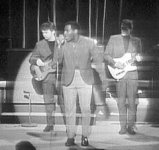Steve Cropper ~ Guitarist Extraordinaire
 Steve Cropper pulls the strings on his Gibson Guitar while Booker T. acknowledges the solo on his Hammond B-3. In this previously unpublished photograph shot on stage in 1969 at The Atlanta Pop Festival, guitar legend Steve Cropper from Booker T. & The MG's is tapping his toe and center of attention while playing the smash hit "Hip Hug Her."
Steve Cropper pulls the strings on his Gibson Guitar while Booker T. acknowledges the solo on his Hammond B-3. In this previously unpublished photograph shot on stage in 1969 at The Atlanta Pop Festival, guitar legend Steve Cropper from Booker T. & The MG's is tapping his toe and center of attention while playing the smash hit "Hip Hug Her."Sometimes it boggles the mind when you stop and think about the musical footprints left across the universe by the still active and ever-present Steve Cropper. What can be said about this famed guitarist of Booker T. & The MG's that hasn't been said before? After all, he's only been around the music scene since the early 1960's. While visiting with Cropper recently, I found him to still be the charmer and posses unfailing street smarts. Somehow he's always had the magic ability to walk into a studio and put people at ease while making things happen. Cropper was a founding member of the high-school band sensation The Mar-Keys whose instrumental hit "Last Night" was the cornerstone of Stax Records. He played with many groups of musicians around the Stax studio, the most successful of which was Booker T. & The MG's who provided the musical punch for many of Stax's knock-out hits. Of course there was "Green Onions," "Cruisin'" and "Time is Tight" plus dozens of other hits by Booker T. & The MG's. However, The MG's were almost like a side-project for him with everything else going on in the studio. When Steve Cropper became right-hand man to Stax President Jim Stewart after the departure of producer Chips Moman, numerous recording projects began developing. Stewart also trained Cropper while preferring his easy going nature which was reflective of his. As Cropper molded his own identity, he would emerge as engineer, producer and write songs for many of the artist that would become major figures in the world of Soul Music. He co-wrote the hits "Knock on Wood" with Eddie Floyd, "Sookie Sookie" and "Don't Fight It" with Don Covay and with many more to follow. A good example of Cropper's legend unfolding was when he was summoned to 'Play it Steve' on Sam and Dave's monster hit, "Soul Man."
In the early 1970's, Cropper departed the Stax fold and rather than cast his hook into the debts of the world market he opened his own Memphis-based recording facility, Trans Maxius Inc Recording Studio (TMI Studio). As a self-contained and low-profile business person, he chose a conservative and workmanship approach at producing music. An early client coming into TMI Recording Studio was the avant-garde guitarist Jeff Beck who solicited Cropper to play lead guitar on several tracks of his album. Surprisingly, Cropper turned down Beck's request feeling that his lead guitar was no equal to Becks. Hmm...Imagine that? Personally, I found this hard to believe coming from a legend known for his soulful Fender Telecaster. However, a modest Steve Cropper later defended his actions and confided, "I really didn't learn to play fluent lead guitar until after opening TMI Studios." But Cropper continued with his observation, "Shoot, guitarist are all different. For years I'd see guitarist come into the studio and change their guitar strings before each session. Man, I never changed my guitar strings. I'd let'em stretch into place and play'em forever. I'd even apply Chap-Stick to my guitar strings to break'em-in and enable my fingers to slide across the neck. It just made the guitar sound so much better that way," Cropper concluded.
Somehow during the course of our conversation I mentioned the final days of Stax. Those days were very painful for both of us whereas we witnessed the mother ship go down. Cropper sat-up in his chair and cleared his throat while offering a word to the wise. He said, "None of that crap matters anymore Phillip." He continued, "You see, nowadays it's all about the music, Man." Having listened to his wisdom once again, Cropper was indeed right. How could I have doubted him? "Nowadays, it's all about the music."
Through the years, Steve Cropper would go on to work with the likes of Rod Stewart, Paul Simon, Elton John, John Mellencamp, Tower of Power, John Prime, Ringo Starr, John Lennon, The Blues Brothers and countless other music legends.
 Steve Cropper (on right) is reunited with long time associate Phillip Rauls during the grand opening of The Stax Museum of American Soul Music and the Stax Music Academy in 2003. Speaking of Phillip, he is the editor of THE PHOTOLOG while Cropper was present at the original job interview that brought Phillip on-board at Stax Records as Local Promotion Manager for the Mid-South back in Janurary of 1968. Later in 1974 Phillip later became the Stax Pop Promotion Coordinator while in 1975 he became the Director of Professional Activities for STAX's publishing company, East/Memphis Music. Rauls has promoted many of Cropper's records with Booker T. & The MG's such as "McLemore Avenue" and also the classic "Jammed Together" by Albert King, Pop Staples and Cropper plus a solo effort on STAX by Steve Cropper titled, "With a Little Help From My Friends."
Steve Cropper (on right) is reunited with long time associate Phillip Rauls during the grand opening of The Stax Museum of American Soul Music and the Stax Music Academy in 2003. Speaking of Phillip, he is the editor of THE PHOTOLOG while Cropper was present at the original job interview that brought Phillip on-board at Stax Records as Local Promotion Manager for the Mid-South back in Janurary of 1968. Later in 1974 Phillip later became the Stax Pop Promotion Coordinator while in 1975 he became the Director of Professional Activities for STAX's publishing company, East/Memphis Music. Rauls has promoted many of Cropper's records with Booker T. & The MG's such as "McLemore Avenue" and also the classic "Jammed Together" by Albert King, Pop Staples and Cropper plus a solo effort on STAX by Steve Cropper titled, "With a Little Help From My Friends."  Perhaps Steve Cropper's finest session work and songwriting was with Otis Redding. Steve Cropper and Otis Redding co-wrote the mega-hits, "Pain in My Heart," "Mr. Pitiful" and the legendary, "Dock of The Bay." Booker T. & The MG's backed Otis Redding in the recording studio and also on the road as his touring band as seen here with (L-R) Duck Dunn on Bass, Otis Redding in center and Steve Cropper on guitar.
Perhaps Steve Cropper's finest session work and songwriting was with Otis Redding. Steve Cropper and Otis Redding co-wrote the mega-hits, "Pain in My Heart," "Mr. Pitiful" and the legendary, "Dock of The Bay." Booker T. & The MG's backed Otis Redding in the recording studio and also on the road as his touring band as seen here with (L-R) Duck Dunn on Bass, Otis Redding in center and Steve Cropper on guitar. Steve Cropper's collaborative relationship with Wilson Pickett produced the R&B classics "In The Midnight Hour," "634-5789," "Don't Fight It," and "Ninety-Nine and One-Half (Won't Do)." Although several of Wilson Pickett's biggest hits on Atlantic Records were cut at STAX Recording Studio in Memphis, Pickett also recorded at Fame Recording Studio in Muscle Shoals, Alabama. He was known for his sensuous soul and raspy vocals that produced an unbridled style of dance music which teenagers endured. Wilson Pickett was inducted into the Rock N' Roll Hall of Fame in 1991. Sadly on Thursday Jan. 19th, 2005, Pickett passed away of a fatal heart attack.
Steve Cropper's collaborative relationship with Wilson Pickett produced the R&B classics "In The Midnight Hour," "634-5789," "Don't Fight It," and "Ninety-Nine and One-Half (Won't Do)." Although several of Wilson Pickett's biggest hits on Atlantic Records were cut at STAX Recording Studio in Memphis, Pickett also recorded at Fame Recording Studio in Muscle Shoals, Alabama. He was known for his sensuous soul and raspy vocals that produced an unbridled style of dance music which teenagers endured. Wilson Pickett was inducted into the Rock N' Roll Hall of Fame in 1991. Sadly on Thursday Jan. 19th, 2005, Pickett passed away of a fatal heart attack.Editors note: An additional posting on Steve Cropper & Booker T. & The MG's can resourced in THE PHOTOLOG's Archives dated; May 2005






prauls%20001.jpg)